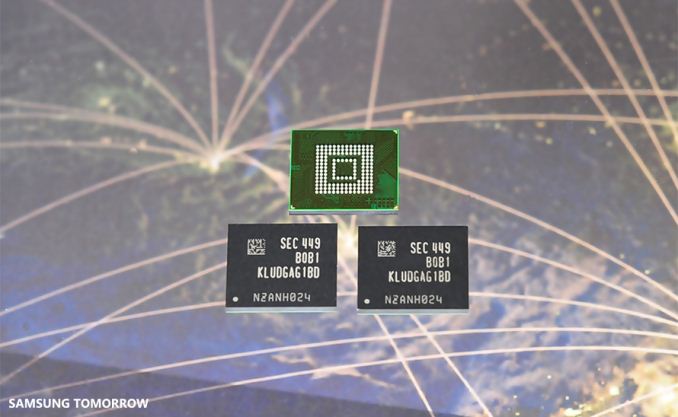Samsung Announces 128GB UFS Storage For Smartphones
by Andrei Frumusanu on February 25, 2015 7:55 PM ESTWe've first heard about plans to adopt UFS (Universal Flash Storage) with the announcements of Toshiba and Qualcomm reported over a year ago. While the promised late 2014 schedule seems to have been missed, and we still haven't seen any major product with the technology, it looks like UFS is finally gaining some traction as today Samsung is announcing the mass production of in-house solutions based on the UFS 2.0 standard.
Samsung claims to provide the new embedded memory type in 32GB, 64GB and 128GB capacities. The 128GB model doubles the amount of storage even their biggest eMMC storage solution is able to deliver. It was only last week that Samsung recently released a new eMMC 5.1 based NAND line-up which promised major gains over today's deployed eMMC products.
The UFS solution claims to achieve 19K IOPS (Input/output operations per second) in reads, almost double that of the 11K IOPS their eMMC 5.1 solution is capable of, and 2.7X times what common embedded memory is capable of today. There is also a purported boost to sequential read and write performance to SSD levels, although Samsung doesn't provide any actual figure, so we'll have to wait until we review a device to see what the actual gains are. What should be very interesting is a promised 50% decrease in energy consumption. We're still not very sure on the impact of eMMC power on a smartphone's battery life, but scenarios such as video recording are certain use-cases where a decrease in NAND power could be very beneficial to battery life.
UFS is based on a serial interface as opposed to eMMC's parallel architecture, enabling Full-Duplex data transfer and achieving twice to four times the peak bandwidth (depending on implementation) over the existing eMMC 8-bit interface.

Samsung offers the solution also in an ePoP package, meaning the NAND IC is embedded with the RAM ICs in a PoP package on top of the SoC, a solution already employed in the Galaxy Alpha and Galaxy Note 4. The goal here is to save on precious PCB space in small form factors such as smartphones.
We're looking forward to see in what kind of devices Samsung implements the technology and how it affects their performance and responsiveness.
Source: Samsung Tomorrow











31 Comments
View All Comments
nandnandnand - Wednesday, February 25, 2015 - link
16 GB can't die soon enough.CaedenV - Wednesday, February 25, 2015 - link
forget about 16GB, look at all of the phones and tablets coming out with only 8GB onboard! 32GB should be a minimum standard in this day and age.Murloc - Thursday, February 26, 2015 - link
8 GB are enough for me and most people who buy cheap phones, that's why it exists.I don't need to load a whole music library on it, nor do I play games on my phone.
cwolf78 - Thursday, February 26, 2015 - link
No, it's not. As long as people like you are around, then OEM's are going to keep charging exorbitant prices for incremental capacity increases. The industry needs to move forward, not be held back by such restrictions. By your logic, Intel should still be making 486's!LordanSS - Thursday, February 26, 2015 - link
I have a dual chip smartphone with 4GB of internal NAND storage. I put the rest of my stuff on a class-10 64GB microSD card.To each their own, but I'm quite happy with what I got, low end and all.
lizardsquad - Friday, February 27, 2015 - link
Nobody except hardcore techies require 128gb onboard... For some odd reason, there is a chunk of techies who refuse to use cloud storage for some odd conspiracy reasons... Its quite odd and ironic that self described techies refuse to adopt new technologies. I've been perfectly fine with 8gb because I have 200gb OneDrive at all times.Denithor - Friday, February 27, 2015 - link
Conspiracy theories, my ass. I don't use cloud storage because it burns through bandwidth like crazy. I only have a half-gig on my plan so I cannot afford to access the cloud every time I want to look at a picture or play a song.sonicmerlin - Sunday, March 1, 2015 - link
To be fair Windows Phone handles SD storage seamlessly. It treats it like it's internal NAMD.Zap - Thursday, February 26, 2015 - link
Not just that, but the stupid partitioning and app location limitations.My phone has 8GB storage and a microSD slot, but only 1.5MB "User application space" and 4GB "internal storage" (remainder is for OS?). Yup, I can only install 1.5GB of apps.
NoWayMan - Wednesday, February 25, 2015 - link
Need to add an 'r' to Smartphones in the title... unless you're trying to spell it phonetically for people from Boston.